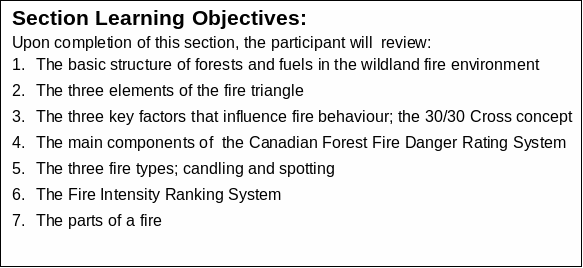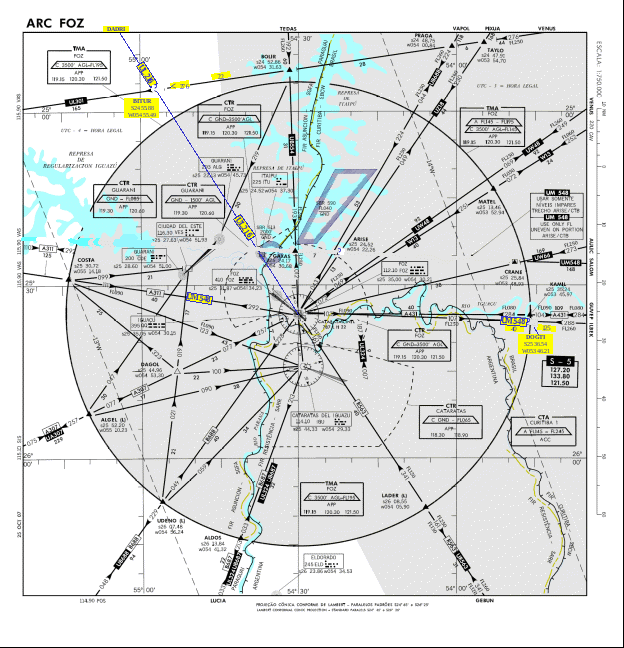4 F FIRE BEHAVIOUR REVIEW POWER POINT PRESENTATION
OBSERVATIONS FROM CAMERAS MONITORING SNAIL BEHAVIOUR MICHAEL RICHARDS117 DRIVER BEHAVIOUR ON RURAL ROADS IN SCOTLAND STEPHEN
18 MARCH 2022 DEAR STUDENT 10 PERSONAL BEHAVIOUR AS
1ST SEMESTER ORGANISATIONAL BEHAVIOUR CODE COM15101CR CORE COURSE TITLE
4 F FIRE BEHAVIOUR REVIEW POWER POINT PRESENTATION
8 THE ECONOMIC BEHAVIOUR OF A SPANISH TOWN IN
Contents

F
FIRE BEHAVIOUR REVIEW
POWER POINT PRESENTATION
IRE BEHAVIOUR REVIEW

Forest Layers
If the course is being taught in a building that has good examples of forest layers and forest fuels in the immediate vicinity, take the students outside to look at the fuels first hand rather than by using the power point
Forest Fuels
The Fire Triangle
Fuel- forest vegetation
Oxygen- in the air
Heat- lightning, people
= FIRE!
Bring in a sample or samples of forest fuels (small log, branches needles), various sizes and densities will also help you describe fuel size later in this section.
Collapsing the Triangle
Remove heat, Remove Fuel, remove Oxygen
Heat Transfer Process
Radiation: through the air from warm surfaces to cooler surroundings (the heat you feel when you are sitting next to a campfire)
Convection: movement of a hot air mass; usually upwards (burning objects below heat objects above)
Conduction: through solid matter (objects touching each other).
Factors Influencing Fire Behaviour
|
Key Factors |
||
|
1. Fuel |
2. Weather |
3. Topography |
|
Moisture |
Wind |
Slope |
|
Size |
Precipitation |
Aspect |
|
Spacing (continuity) |
Relative Humidity |
Terrain |
|
Fuel Loading |
Temperature |
Elevation |
Fuel Moisture
Most important fuel factor
Fuel moisture is determined by :
Weather related factors affecting the amount of moisture in the fuel.
Percentage of live or dead (cured) fuel.
A hair dryer used on a piece of wet cloth can be used to simulate wind blowing warm dry air over the fuel and drying it (reducing fuel moisture)
Heavy, Slow Burning Fuels
logs, stumps, large branch wood, trees and deep duff.
longer to ignite
fires spread slowly
greater intensity.
low surface area to volume ratio.
Light, Fast Burning Fuels
grass, dead leaves, tree needles, brush and small trees. ignite quickly,
fast spreading fires
act as kindling to light heavier fuels.
high surface area to volume ratio.
If you are able to access good examples of forest fuels in the immediate vicinity, use examples outside
Fuel Spacing
Horizontal Fuel Spacing
“continuous” or “patchy”.
Affects ability of horizontal fire spread
Vertical Fuel Spacing
distance between surface fuels and aerial fuels.
ladder fuels.
Fuel Loading
the weight or mass of fuels in a given area
usually measured in tonnes per hectare
may vary across the landscape
Higher density fuel loads will burn at higher intensities if fuel moisture conditions make all the fuel available for combustion
Pass around a tray with fuels tightly piled and compare it to a tray with the same fuels dispersed over a large area. Have participants compare weights and density
Wind
Single most important weather factor
Increases or decreases fuel moistures
Bends flames ahead heating, drying and igniting new fuels
Carries sparks and embers into new fuel sources (spotting)
Feeds fire with Oxygen
Drives the direction of the fire
Precipitation
Less precipitation required to raise fine fuels fuel moisture than in heavy fuels
Fine fuels dry faster than heavy fuels
Precipitation may not wet ground fuels if they are positioned under a dense canopy
Duration of precipitation, not quantity, is the most important factor
Relative Humidity
Influences fire behaviour by affecting fuel moisture.
Percentage of water vapour present in the air.
When the air is dry (low Relative Humidity), fuels are likely to dry out.
When the air is damp (high Relative Humidity), fuels are likely to absorb moisture (fuel moisture increases)
Increases overnight and decreases during the day. (recovery)
Temperature
Temperature fluctuations affect relative humidity, affecting fuel moisture content.
Influences the amount of preheating required to bring fuel to it’s ignition temperature.
30/30 Cross
Watch for extreme fire behaviour!
Condition where the RH drops below 30% and temperature rises about 30ºC.
Useful rule of thumb to potentially expect extreme fire behaviour – precautions must be taken accordingly.
Canadian Forest Fire Danger Rating System
Standard national fire danger rating system in Canada
Fire potential and fire spread rates used to determine day-to-day preparedness
Two sub-systems
Fire Weather Index (FWI) system
Fire Behaviour Prediction (FBP) system
Fire Weather Index
FFMC, DMC. DC
Fire Behaviour Index
ISI Initial Spread Index
Relative fire spread immediately after ignition
BUI Build Up Index
Total amount of fuel available for consumption
FWI Fire Weather Index
Potential fire intensity
Fire danger levels
Fire Behaviour Prediction System
The FBP system evaluates:
FWI indices on site or from the nearest weather station
Fuel type (17 different fuel types)
Topography (slope and aspect)
Time of day / time of year
Primary outputs of the FBP system are:
Rate of Spread (metres per minute)
Fire Type (ground, surface, crown)
Fire Intensity (kilowatts per metre)
Fire Types
Ground Fire
Surface Fire
Crown Fire
EXERCISE
Write these indices on the flip chart
or white board and ask students to describe the fire type, ROS and
intensity they expect to see
O800 in the morning
1600 in the afternoon
FFMC 90
DMC 42
DC 320
ISI 13
DMC 31
BUI 93
6 days since major rain
hot and dry
spring after a low
precipitation winter
STUDENT PARTICIPATION
Slope
Most important topographical factor
Flames are closer to fuels uphill
Convective heat (rising heat) travels up slope
Convective air carries firebrands igniting spot fires above
Burning embers and large burning material roll downhill igniting spot fires below
Firefighting efforts are hampered and slowed on slopes
Cooling at night and weather changes down slope.
Aspect
The direction the slope faces
Southern slopes receive the most direct heat from the sun and therefore have higher temperatures
Vegetation on south facing slopes typically has the lowest fuel moisture
Terrain
Variation in land features altering wind direction and speed
Turbulence or “eddies” can be generated on the leeward side when wind blows across ridges
Terrain restrictions, such as narrow portions of valleys, or knolls, can increase wind speed as the wind passes through, or around these restrictions.
Steep-sided gullies or canyons running uphill can create a “chimney effect” dramatically increasing uphill spread rates and intensity.
Elevation
Temperatures are usually decrease with elevation.
A band of warm air and low humidity can be trapped at mid- elevation between cool air below and cool air above.
In the mountains, this is a thermal belt.
Can create extreme fire conditions when unexpected
Fire Intensity Rank
Rank 1
Rank 2
Rank 3
Rank 4
Rank 5
Ranks 6
Definitions
Candling - A single tree or a small clump of trees igniting and flaring up
Spotting - firebrands (embers) carried by the wind, a fire whirl or a convection column that fall beyond the main fire and result in spot fires .
Parts of a Fire
Head
Flank
Back
Finger
Island
Bay
Spot Fire
Hot Spot
S-235![]()



9 BEHAVIOUR PROBLEMS IN CHILDREN AND ADOLESCENTS WITH VISUAL
A APPENDIX A AGENDA ITEM NO 17 NTISOCIAL BEHAVIOUR
A PERSONAL EXPERIENCE OF USING BEHAVIOURAL FAMILY THERAPY TECHNIQUES
Tags: behaviour review, fire behaviour, review, behaviour, power, point, presentation
- CONTRATO ENTRE Y D PROFESOR DEL DEPARTAMENTO
- UNIVERSITÉ D’OTTAWA · UNIVERSITY OF OTTAWA ÉCOLE DINGÉNIERIE ET
- SINTESIS DESPIDO OBJETIVO CAUSAS ECONÓMICAS PUESTA A DISPOSICIÓN DE
- INTRODUCIR EL LOGO DE LA EMPRESA (OPCIONAL) NOMBRE DEL
- INTRODUCCIÓN LA POBREZA ES UNO DE LOS PROBLEMAS MÁS
- CHS DAILY BULLETIN WEEK OF MAY 17 THRU 21
- BUDAPEST UNIVERSITY OF TECHNOLOGY AND ECONOMICS FACULTY OF CHEMICAL
- DALL’ILIADE RIASSUNTO DEL BRANO “LA MORTE DI ETTORE” ETTORE
- HEAD COACH CEP LEVEL YEAR EXPIRED SIGNATURE ASST
- INTRODUCCIÓN | 15 INTRODUCCIÓN EN ESTA COMPILACIÓN SE
- MÚSICA LA MÚSICA COMO BIEN CULTURAL Y COMO LENGUAJE
- ANEXO 3 CONSENTIMIENTO INFORMADO AMPLIO PARA USO DE DATOS
- KRAJEVNA SKUPNOST DOKLEŽOVJE GLAVNA ULICA 18 9231 BELTINCI
- 7 HỘI ĐỒNG NHÂN DÂN TỈNH NAM ĐỊNH SỐ
- INTRODUÇÃO AO PROCESSO DE POISSON A DISTRIBUIÇÃO DE
- FIRST AND SECOND GRADE SCREENING SPEECH AND LANGUAGE NAME
- Rotation Rotation Rotation Cover Crops can Suppress Weeds Weeds
- CÔNG TY CP PHẦN MỀM MELIASOFT MELIASOFT JOINT STOCK
- TEXTOS PRIMER CICLO PRIMARIA (PRIMERO) NIVEL EDITORIAL TÍTULO 1º
- BİNALARDA TOPRAKLAMA TESİSLERİNDE YAPILACAK GÖZLE MUAYENEDENETLEME VE ÖLÇMEYE İLİŞKİN
- 0 N248802 JANUARY 16 2014 CLA284OTRRNC1104 CATEGORY CLASSIFICATION TARIFF
- 3 OMAR OBANDO SUÁREZ 5 DE OCTUBRE 2004 DIVISIÓN
- JADWAL KEGIATAN PESERTA MAGANG DIKTI DI PUSAT PENGEMBANGAN PENDIDIKAN
- FICHE PROFESSEUR THÈME DU PROGRAMME 1ÈRES OBSERVER –
- ANNUAL AUDITED ACCOUNTS CHECKLIST AGENCY AAAS REPORTING YEAR DATE
- UNIVERSIDAD CENTRAL DE VENEZUELA FACULTAD DE FARMACIA CONSEJO DE
- INTRODUCCIÓN EL REINO UNIDO DE GRAN BRETAÑA E IRLANDA
- DODATAK 5 KRITERIJI ODABIRA PROJEKTNIH PRIJEDLOGA ZA PROVEDBU LRS
- INFORMATION TILL DIG I ÅK 6 OCH 7 INFÖR
- LIQUIDATED SAVINGS FOR EARLY COMPLETION (REV 51899) (FA
OBSZAR EWALUACJI PROCESY ZACHODZĄCE W SZKOLE WYMAGANIE PROCESY ZACHODZĄCE
SIXTH SCHEDULE REGULATION 16 (2) THE REPUBLIC OF UGANDA
 QUEEN ELIZABETH LIONS! PARENT NEWSLETTER – NOVEMBER 2020 OCTOBER
QUEEN ELIZABETH LIONS! PARENT NEWSLETTER – NOVEMBER 2020 OCTOBER EL COL·LECTIU DE TREBALL SOCIAL DE CA REVOLTA EXPRESA
EL COL·LECTIU DE TREBALL SOCIAL DE CA REVOLTA EXPRESA AVISO DE ESTADO CONDICIONAL DE VACUNACIÓN DE SU HIJO
AVISO DE ESTADO CONDICIONAL DE VACUNACIÓN DE SU HIJONOTULEN LEDENRAADPLEGING VERENIGING FRIESE GEMEENTEN HEERENVEEN 5 JULI 2006
 SANTA BARBARA COUNTY AGRICULTURAL ACTIVITIES SUPPLEMENT PAGE 2 AGRICULTURAL
SANTA BARBARA COUNTY AGRICULTURAL ACTIVITIES SUPPLEMENT PAGE 2 AGRICULTURAL PROGRAMA INSTITUCIONAL DE BOLSAS DE INICIAÇÃO CIENTÍFICA – ENSINO
PROGRAMA INSTITUCIONAL DE BOLSAS DE INICIAÇÃO CIENTÍFICA – ENSINODÜ ÖĞRETİM ELEMANI GİRİŞ SINAVI DEĞERLENDİRME TUTANAĞI (ÖNLİSANS) BİRİMİ
EXPERIENCIA ERASMUS ISCTE (INSTITUTO SUPERIOR DE CIENCIAS DO TRABALHO
JANUARY 2020 FEBRUARY 2020 MARCH 2020 SU MO TU
 SAM ATMCNS MULTINE49 A19 APÉNDICE A CARTA DE ACUERDO
SAM ATMCNS MULTINE49 A19 APÉNDICE A CARTA DE ACUERDO LEMONIADA KONKURS LITERACKI I FILMOWY INSPIROWANY TWÓRCZOŚCIĄ STANISŁAWA
LEMONIADA KONKURS LITERACKI I FILMOWY INSPIROWANY TWÓRCZOŚCIĄ STANISŁAWA CBND0109425 ÁREA SECRETARÍA PATRIMONIO REF MRR PLIEGO DE
CBND0109425 ÁREA SECRETARÍA PATRIMONIO REF MRR PLIEGO DE PRIJEDLOG AKTIVNOSTI ZA DJECU OD 4–7 GODINA
PRIJEDLOG AKTIVNOSTI ZA DJECU OD 4–7 GODINA INFORMACIJA APIE PRADEDAMĄ PIRKIMĄ 2015 M SPALIO 15 D
KATOWICE 1 LUTEGO 2021 R ZMIANY DO REGULAMINU XI
 PROGRAMACIÓN DEL MODULO DE 3013 IED
PROGRAMACIÓN DEL MODULO DE 3013 IED  FIGURE S1 DENGUE INCIDENCE IN JUNGLE AREAS OF PERU
FIGURE S1 DENGUE INCIDENCE IN JUNGLE AREAS OF PERUFORMULIR PERMOHONAN BEASISWA PENDIDIKAN PASCASARJANA DN PASCASARJANA TAHUN